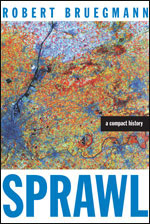Views of the suburbs
 Sunday’s San Jose Mercury News carried an interesting review of an exhibit at the San Jose Museum of Art. The exhibit gathers photographs, paintings, and sculpture on the theme of suburbia—so appropriate for the heart of Silicon Valley.
Sunday’s San Jose Mercury News carried an interesting review of an exhibit at the San Jose Museum of Art. The exhibit gathers photographs, paintings, and sculpture on the theme of suburbia—so appropriate for the heart of Silicon Valley.
The Mercury News reviewer, Alan Hess, takes the exhibit to task however, and juxtaposes what he sees as typical condescending attitude towards suburban development with the insights of one of our authors, Robert Bruegmann, whose book Sprawl: A Compact History works to overturn the conventional wisdom on suburbia. Hess writes:
Vacant neighborhoods, sterile landscapes, and scary people dominate the exhibit “Suburban Escape: The Art of California Sprawl,” at the San Jose Museum of Art … . But until we stop repeating these myths—and stop basing architectural and planning policies on them—suburban cities such as San Jose will never achieve their full potential.
Fortunately, some serious academics are taking a fresher look at the facts. A 2005 book with the catchy title Sprawl: A Compact History, by University of Illinois Professor Robert Bruegmann is one excellent antidote to decades of flawed opinions.
As it happens though, we have dogs on both sides in this fight. The catalog for the exhibition, Suburban Escape: The Art of California Sprawl, is published by the Center for American Places, whose publications we are pleased to distribute. So, while Mr. Hess seems to have made up his mind, we invite you to look at both of these intriguing new works on the future of American city planning and the diverse viewpoints they provide.
We have an excerpt from Sprawl.